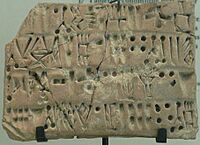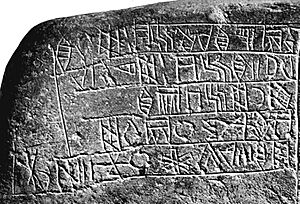Elamite language facts for kids
Quick facts for kids Elamite |
|
|---|---|

Tablet of Elamite script
|
|
| Native to | Elam |
| Region | Western Asia, Iran |
| Era | c. 2800–300 BC (Later unwritten forms might have survived until 1000 AD?) |
| Language family | |
| Early forms: |
language of Proto-Elamite?
|
| Writing system | Linear Elamite, Elamite cuneiform |
| Linguist List | elx |
Elamite was an extinct language spoken by the ancient Elamites. These people lived in what is now southwestern Iran. People used Elamite from about 2600 BC until 330 BC.
Elamite is special because it doesn't seem to be related to any other known language. This makes it a language isolate. Because it has no clear relatives, understanding it fully has been a challenge for experts.
We know many Elamite words from old royal writings of the Achaemenid Empire. These writings were often in three languages, including Elamite. The Elamite part was written using Elamite cuneiform around 400 BC. This script has been fully figured out. A big dictionary of the Elamite language was published in 1987. Another old script, Linear Elamite, was used around 2000 BC. For a long time, this script was a mystery, but it has recently been partly deciphered.
Contents
How Was Elamite Written?

Elamite was written using different systems over time:
- The Proto-Elamite script is the oldest writing system from Iran. It was used for a short time, from about 3100 to 2900 BC. Clay tablets with this writing have been found across Iran. It had over 1,000 signs and is mostly made of pictures representing words. This script has not been fully deciphered.
- Linear Elamite is found on a few large stone carvings. It might have been a system where signs stood for syllables or a mix of syllables and words. Parts of it have been deciphered. Some believe it grew from Proto-Elamite, but this is still debated. Linear Elamite was used for a very brief time around 2000 BC.
Later, people used Elamite cuneiform, which was based on the Akkadian cuneiform script. This started around 2500 BC. Elamite cuneiform mostly used signs for syllables, about 130 of them. It had only a few signs for whole words at first, but more were added over time. We have about 20,000 tablets and pieces written in Elamite cuneiform. Most of these are from the Achaemenid period and are mainly business records.
How Elamite Grammar Worked
Elamite is an agglutinative language. This means it adds many suffixes to words to change their meaning. Its grammar had a complex system for nouns. Nouns were grouped into classes, like "animate" (living things) and "inanimate" (non-living things).
Animate nouns also had different markers for "first person" (like "I"), "second person" (like "you"), and "third person" (like "he/she/it"). What's interesting is that these markers were added not just to the main noun, but also to any words that described it, like adjectives.
A Timeline of Elamite History

The history of the Elamite language is divided into different periods:
- Old Elamite (around 2600–1500 BC)
- Middle Elamite (around 1500–1000 BC)
- Neo-Elamite (1000–550 BC)
- Achaemenid Elamite (550–330 BC)
- Late Elamite?
- Khuzi? (Unknown – 1000 AD)
Middle Elamite is seen as the "classic" form of the language. However, we have the most writings from the Achaemenid Elamite period. The Achaemenid Persian state used it widely for official writings and records. This later form of Elamite was influenced by Old Persian.
Many Elamite documents were found in the Persepolis Administrative Archives in the 1930s. Over 10,000 of these cuneiform tablets have been discovered. They show how the administration worked in Persepolis for more than 50 years (509 to 457 BC).
Writings from the Old Elamite and early Neo-Elamite periods are quite rare. Neo-Elamite is seen as a bridge between Middle and Achaemenid Elamite in terms of its language structure.
Elamite might have been used for a long time after the Achaemenid period. Some rulers of Elymais in the 2nd and 1st centuries BC had Elamite names. The Acts of the Apostles (around 80–90 AD) even mentions Elamite as if it was still spoken.
Later, there are no direct mentions of Elamite. However, some believe it might be the local language called Khuzi or Xūz. Arabic writers between the 8th and 13th centuries AD mentioned this language. It was spoken in Khuzistan and was different from other Iranian languages. This Khuzi language might have been a late version of Elamite.
The last original report on the Xūz language was around 988 AD. It said that people in the town of Ramhormoz spoke Arabic and Persian, but also an "incomprehensible" language. This suggests the language likely died out in the 11th century.
How Elamite Sounds and Words Worked
It's hard to know exactly how Elamite sounded because of the limitations of its writing systems. We know it had sounds like 'p', 't', 'k', 's', 'sh', 'z', 'm', 'n', 'l', 'r', and 'h'. The 'h' sound was lost in later Elamite. It had at least the vowel sounds 'a', 'i', and 'u'.
Elamite words were often built by adding suffixes. It used fewer suffixes per word compared to languages like Sumerian.
Nouns in Elamite
Elamite nouns had a special system that combined whether something was living (animate) or not (inanimate) with who was speaking (first, second, or third person). For example, a king could be "my king" (first person), "your king" (second person), or "a king" (third person).
These special endings were added to nouns and also to words that described them. For instance, "my god" would have the "my" ending on "god."
Verbs in Elamite
Elamite verbs had different forms to show when an action happened (past, present, future) and how it happened (like a completed action or an ongoing one). They also had forms for commands (imperative) and wishes (optative).
The main verb forms were called "conjugations." One form was used for actions that were completed in the past. Other forms were used for ongoing actions or actions that would happen.
For example, "I prayed" would use one set of endings, while "he did" would use another.
How Sentences Were Built
In Elamite, words usually followed a subject–object–verb (SOV) order. This means the subject comes first, then the object, and finally the verb. For example, "I (subject) the ball (object) threw (verb)."
Elamite also used postpositions, which are like prepositions but come after the noun. An example is -ma meaning "in" or -na meaning "of."
Elamite Language Samples
Here's an example from Middle Elamite (around 1200–1160 BC), from King Šutruk-Nahhunte I:
And an example from Achaemenid Elamite (around 486–465 BC), from King Xerxes I:
A great god is Ahura Mazda, who created this earth, who created that sky, who created man, who created happiness of man, who made Xerxes king, one king of many, one lord of many.
Are There Any Related Languages?
Most linguists believe Elamite is a language isolate. This means it doesn't have a clear connection to nearby languages like Semitic languages, Indo-European languages, or Sumerian. Even though it used the Sumerian-Akkadian cuneiform script, it's not related to those languages.
However, some researchers have suggested a link between Elamite and the Dravidian languages spoken in India and Pakistan (like the Brahui language). This idea is called the Elamo-Dravidian family. Recent studies of ancient DNA have made this possible connection more interesting.
Other ideas have also been proposed, like a link to Semitic languages, but these ideas are not widely accepted by most language experts.
See also
- Gutian language

